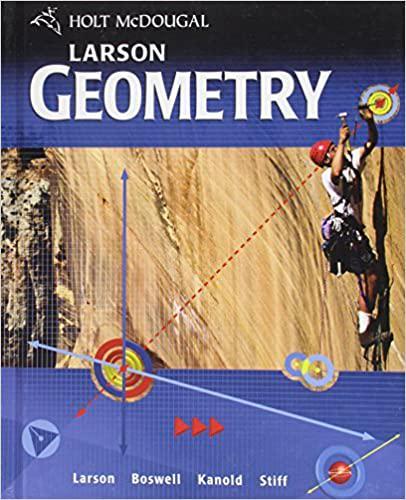Question
1. The basic purpose of preparing a trial balance is: A. to find out profit of the business B. to show financial position of the
1. The basic purpose of preparing a trial balance is:
A. to find out profit of the business
B. to show financial position of the business
C. to test arithmetical accuracy of the ledger
D. to calculate net purchases of the business
2. Which of the following is correct about an agreed trial balance.
A. both debit and credit aspects of each transaction have been recorded
B. the books are arithmetically correct
C. the debit and credit columns of trial balance have been correctly totaled
D. all of these
3. Which one of the following represents correct sequence of accounting cycle?
A. Journal > Trial balance > Ledger > Transaction analysis
B. Transaction analysis > Journal > Ledger > Trial balance
C. Purchases > Journal > Ledger > Trial balance
D. None of these
4. In addition to arithmetical accuracy of ledger, a trial balance provides:
A. A summary of total capital invested in the business during the period
B. A summary of sales made during the period
C. A summary of total cash collected from customers during the period
D. A summary of all transactions made since the end of the previous accounting period
5. Which one of the following is the most popular method of preparing a trial balance:
A. Balance method
B. Total method
C. Trial and error method
D. Line method
6. Which of the following errors in the journal entry will not be detected by trial balance.
A. Debit part is overstated but credit part is correctly recorded
B. Debit part is correctly recorded but credit part is overstated
C. Both debit and credit parts are overstated by the same amount
D. Debit part is correctly recorded but credit part is understated
7. Which of the following will be placed in the credit column of the trial balance?
A. Purchases
B. Rent expense
C. Furniture
D. Sales
8. Which of the following will be placed in the debit column of the trial balance?
A. Capital
B. Accounts payable
C. salaries payable
D. None of these
9. Which of the following statements is correct:
A trial balance:
A. is prepared by a business on the last day of its accounting period
B. lists all entries made for accounting for business transactions
C. proves the accuracy of the accounting records
D. lists the balances in all the accounts maintained on double entry basis
10. When attempting to identify accounting errors the trial balance can be relied on to detect which of the following errors:
A. all accounting errors
B. posting to the wrong side of any account
C. transactions not accounted for
D. amounts posted to the correct side of a wrong account
11. Which of the following errors would have caused a difference in the trial balance?
A. Posting to Motor vehicles account N$600 paid for servicing vehicles
B. Not accounting for N$15 000 paid for purchasing goods for sale
C. Posting payment of N$21 000 for stationery as N$12 000 to the Stationery account
D. Recording a sale of N$30 000 as N$3 000 in the Cash Book
12. N$2 400 paid for staff training has been posted in error to Advertising account. Which of the following would be an appropriate description of this accounting error:
A. Error of principle
B. Double entry error
C. Error of commission
D. Error of omission
13. Input VAT is______________________
A. An expense where VAT is claimed.
B. An asset where VAT is claimed.
C. Income where VAT is declared
D. None of these
14. Transactions are first recorded in which book/account?
A. Book of Original Entry
B. T Accounts
C. Accounting Equation
D. Book of Final Entry
15. A journal is also called a?
A. A day book
B. History book
C. Ledger book
D. An entry book
16. Which of the following accounts does not increase with a debit entry?
A. Retained Earnings
B. Buildings
C. Prepaid Rent
D. Electricity Expense
17. Which of the following pairs increase with credit entries?
A. supplies and retained earnings
B. rent expense and unearned revenue
C. prepaid rent and common stock
D. unearned service revenue and accounts payable
18. What type of account is prepaid insurance?
A. Stockholders’ Equity
B. Expense
C. Liability
D. Asset
19. Which of the following accounting records is the main source of information used to prepare the financial statements?
A. journal entries
B. T-accounts
C. trial balance
D. chart of accounts
20. Which of the following financial statements should be prepared first?
A. Statement of Financial position (Balance Sheet)
B. Statement of Comprehensive Income (Income Statement)
C. Retained Earnings Statement
D. Statement of Cash Flows
21. Which of these statements is false?
A. Assets = Liabilities + Equity
B. Assets – Liabilities = Equity
C. Liabilities – Equity = Assets
D. Liabilities = Assets – Equity
22. Which of these accounts is an asset?
A. Common Stock
B. Supplies
C. Accounts Payable
D. Fees Earned
23. Which of these accounts is a liability?
A. Accounts Receivable
B. Supplies
C. Salaries Expense
D. Accounts Payable
Step by Step Solution
There are 3 Steps involved in it
Step: 1
Answers to Your Accounting Questions C to test arithmetical accuracy of the ledger The trial balance helps ensure totals for debits and credits are eq...
Get Instant Access to Expert-Tailored Solutions
See step-by-step solutions with expert insights and AI powered tools for academic success
Step: 2

Step: 3

Ace Your Homework with AI
Get the answers you need in no time with our AI-driven, step-by-step assistance
Get Started


